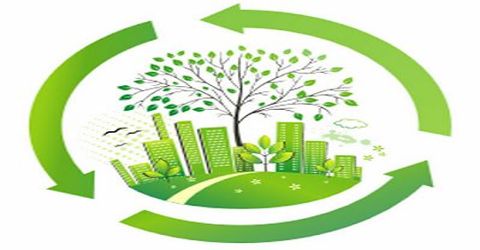Environment
Courtesy : www.vedantu.com/
A simple definition of an environment can be stated as a system encompassing all biotic and abiotic elements affecting human life. The biotic or living components comprise all flora and fauna, and abiotic components include water, sunlight, air, climate, etc.
The resources of an environment can be any matter, service or particulars that are useful to society and human beings. They can be anything that satisfies the needs of daily life. Nourishment from living organisms and plants, fuel for cooking purposes and transportation, wind, oil, etc. are all environmental supplies.
The environment gives out an extensive range of products and services that is required to sustain life. Each resource holds relative importance and has significant value. For example, a slice of land can be turned into a park, housing society, a shopping mall, etc. Moreover, it can be modified into a garbage dumping area as well.
The essential functions of the environment are stated below.
What are the Activities of Environment?
- The Environment Supports Life
The environment provides services that sustain life but does not involve human action. Some of them are climatic stability, protection from ultra-violet rays, and ecological diversity.
- It Enhances and Upgrades the Quality of Living
A pollution-free environment is necessary for a healthy livelihood. Apart from this, all-natural scenic beauties like mountains, seas, deserts, etc. provide enjoyment and satisfaction to an individual. However, people must also make sure to preserve all the natural resources and not pollute them to maintain well-being.
- It Produces Resources for Utilisation.
All natural resources, like renewable and non-renewable energy sources, are produced by the environment. Most of them are essential for living. Organisms use both biotic and abiotic sources. Vegetation and animal products are obtained from plants and creatures. Fossils fuel is generated from the dead and decaying matter of organic substances. Other constituents of the ecosystem, including freshwater, wind, and even metals, are provided by the environment.
- The Environment Absorbs Waste Materials.
The environment can assimilate waste products without inducing any harmful effect on the living creatures. The time when absorption exceeds the assimilative level, it leads to pollution. An example of this kind of capacity is that plants living in water bodies can absorb bacteria, chemicals, etc. According to one research, an aquatic moss named Warnstorfia fluitans can discard arsenic from water.
As mentioned earlier, natural resources are of two kinds:
The two sorts of resources are renewable and non-renewable resources.
- Renewable Resources
These are natural resources that never get depleted with their constant usage. Replenishment of these happens through organic reproduction or continuous processes within limited time duration. These sources take up a large part of the Earth’s natural ecosystem. Some common renewable resources are:
- Water
It is one of the major types of renewable energy sources found on Earth. In recent years, however, due to population boom and rapid urbanisation, it is becoming scarce. For instance, underground water is being used at a much higher rate. On the other hand, its natural restoration is falling comparatively shorter. Furthermore, if statistics are taken into account, 97.5% of water present on Earth is salty. Freshwater amounts to only 3% and two-thirds of it are frozen.
Nevertheless, if water from sea undergoes desalination, it can be counted as an inexhaustible natural source. However, the expense related to desalination is steep.
- Air
Another crucial renewable resource is air. Every living organism requires air to survive. The air in our natural environment contains 78.09% of nitrogen, 0.93% of argon 20.95 of oxygen, 0.04% of carbon dioxide and other gases in small quantities.
- Non-dietary Sources
Wood is a necessary sustainable resource. They are obtainable from forestry and are utilised for building houses, furniture, etc. Trees, herbs, and shrubs generate the maximum number of renewable resources. Many kinds of lubricants, vegetable oils used in the market, cloth materials and fibre, different types of paper, bio-plastics are derived from plant renewable. Numerous chemical-based items like resin, glucose, rubber, latex, starch can be obtained from the greenery present in our environment. On the other hand, animals also produce various sustainable sources. Some of them are leather, animal glue, technical fat, etc.
- Non-Farming Food
Food is a substance that is needed to provide energy and nutrition to a body. The maximum form of foodstuffs originates from renewable resources. It is directly acquired from flora and fauna.
- Non-Renewable Resources
The natural sources that cannot be replenished at the same speed organically, as compared to its consumption are termed as non-renewable energy resources. It’s examples are:
- Fossil Fuels
This category of resources requires a considerable amount of time to form and is not easily restorable. It includes petroleum (also known as crude oil), coal, and fossil gas. In due course, it is contemplated that gathering resources from fossil-fuels will grow expensive.
Hence, humankind will have to be reliable on energy sources like wind or solar power.
- Metallic Ores and Minerals
Vast quantities of metals are available in the layers of Earth’s surface. However, these resources form with the help of natural processes like pressure, weathering, heat, etc. These processes necessitate thousands of years to draw out the minerals and ores.
- Nuclear Propellants
Generally, atomic energy is classified under the renewable energy source, but the elements needed in nuclear units are non-renewable. Uranium is commonly used in these power stations. Though uranium is available across the globe, the power units use a special kind of uranium, namely U-235. This type is a non-renewable element.
Vedantu hopes that this content is sufficient for comprehending the environment’s meaning. For more related topics, you can visit our website or app.





